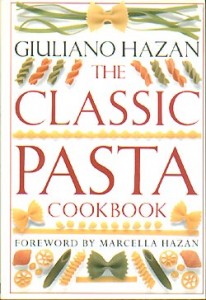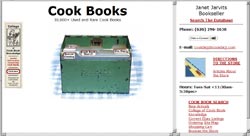Read Giuliano Hazan’s post regarding the e-book edition of The Classic Pasta Cookbook.
Category Archives: 19th Century
Giuliano Hazan updating his Classic Pasta Cookbook with Kickstarter funds
Filed under 19th Century, 20th Century, Classics reprinted, Edition history, Italian, Marketplace, News
Joy of Cooking, page update
Today, I revised and expanded the publishing history of the Joy of Cooking page on the store’s website.
Filed under 19th Century, 20th Century, Edition history, General, Influential
“Joy Of Cooking” research study
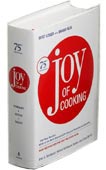
Dr. Brian Wansink, of the Cornell Food and Brand Lab, is the author of a new research study on the Joy of Cooking.
The study involved comparing 18 recipes that have survived the various editions of Joy. 1936, 1946, 1951, 1963, 1975, 1997 and 2006 were the editions used in the study.
Researchers documented the serving size and caloric in each version of the 18 recipes. They found that 17 of the recipes underwent changes that mirrored America’s obestiy epidemic.
Dr. Wasink comments, “What we think is a normal serving size has increased dramatically over the last 70 years … as has what we demand in terms of fat and sugar in a recipe.â€
“According to the study, in 1936, the average number of calories in each recipe was 261. The most recent recipes average 384 calories, an increase of 60 percent. If you were to compare just the recipe for sugar cookies, you would find an 142 percent increase in the number of calories from the 1936 recipe to today’s recipe.
Filed under 19th Century, 20th Century, Edition history, General
Col. Kenney-Herbert’s Culinary Jottings
Today I read an entertaining and informative post about the seminal book on the cuisine of British colonial India, Culinary Jottings for Madras by Wyvern (Col. A. Kenney Herbert).
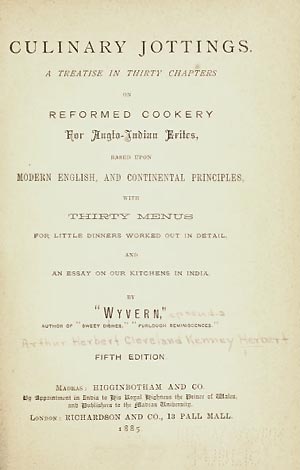
While Col. Kenney-Herbert was stationed in British India he wrote articles for the Madras Atheneum and Daily News under the pen name, “Wyvern.” These articles formed the basis for Culinary Jottings.
According to Alan Davidson (1999),
The colonel believed in surrounding his recipes with historical material, etymological explanations, amusing anecdotes, and, above all, every detail that seemed relevant to him about the choice and purchase of ingredients as well as the preparation of the dish itself.
Besides being the best British colonial Indian cookery book, Culinary Jottings represents a budding genre of cookery writing.
Since I started selling cook books in 1989, I haven’t been lucky enough to come across a copy of Culinary Jottings except at the main branch of the Los Angeles Public Library.
A virtual copy of the fifth edition can be read at the Internet Archive. A reprint with a great introduction is available from Prospect Books.
Filed under 19th Century, Indian, Influential
Soyer’s Culinary Campaign, part 3
Bookbinders Jack and John Papuchyan restored Soyer’s Culinary Campaign for me.
After resewing the page block and inserting it into a new binding, replacing the endpapers with “new” endpapers that are actually old endpapers (contemporary to the book), and covering the new binding with the original cloth, cleaned and restored, the book reads comfortably and looks exceptional.
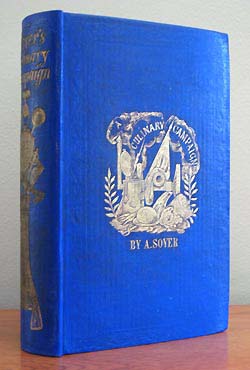
Filed under 19th Century, Biography, Memoirs, Europe, Military
Soyer’s Culinary Campaign, part 2
I launched my business in 1989 while working at Bond Street Books (Book Castle, Inc.) in Burbank, Calif. After four years of growing the business, I made the pivotal purchase of Helen Brown’s cook books.
Although I began to catalogue and sell the collection immediately in order to make the monthly payments I’d agreed upon with her husband, Philip S. Brown, I put a number of books away; earmarking them for archival restoration at some later date.
Most of the books from Helen’s library have found new homes by now, but Soyer’s Culinary Campaign stays with me.
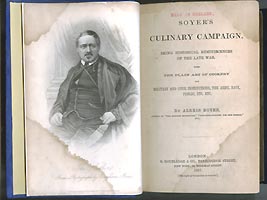
Filed under 19th Century, Biography, Memoirs, Europe, Military
Soyer’s Culinary Campaign, part 1
I’m starting to work on the listing for a rare book that I purchased; as part of a group of food-related books, from the cookery book collection of the late Helen Evans Brown.
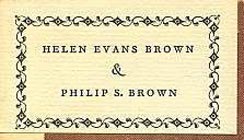
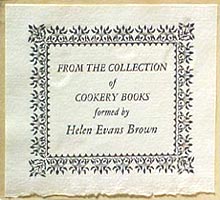
Filed under 19th Century, Biography, Memoirs, Europe, Military
Hunter Sifter Cook Book
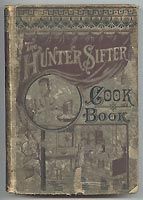 Although I’m off today, I worked on some auction listings; including one for the Hunter Sifter Cook Book.
Although I’m off today, I worked on some auction listings; including one for the Hunter Sifter Cook Book.
The Hunter Sifter Cook Book contains advertisments for a number of Cincinnati businesses.
Several Hunter Sifter M-f-g Co. products are advertised: the Sifter, Cyclone Beater, and Safety Hollow Ware.
Naturally, I found the Hunter Sifter Co. products: Hunter Sifter, Cyclone Egg Beater and Safety Hollow Ware in various forms on the cook book’s recommended list of Kitchen Utensils. And commonplace items: kitchen table and chairs, can opener, nutmeg grater, potato slicer, waffle iron. Other items listed, puzzled me:
- candlesticks
- ash bucket
- coal hod
- hammer
- hatchet
- 3 iron kettles
- lantern
- match box
- 2 iron spoons
- meat saw
- mustard pot
- rubber window cleaner
- tin pails
- wirescreens (assorted sizes)
- sugar box
- salt box
- stepladder
- tin cake box
- wash keeler
- wooden buckets
After further consideration, the items made sense.
A meat saw cuts up a carcass. A pail or bucket carries water or milk from its source to the kitchen. But for a “sugar box,” sugar hardens into a rock in the moist environment of a kitchen, or worse, becomes home, sweet home to a family of worms. Stainless steel and plastic had not yet been invented, so wooden, iron, and steel implements held, chopped, mixed, heated, transported, and safeguarded ingredients. Mousetrap made the list.
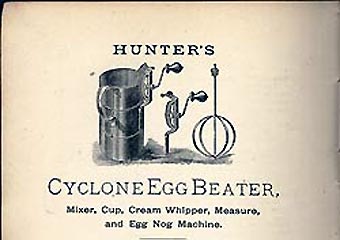
Filed under 19th Century, Cookware & Appliance, Regional
Fannie Farmer trading card
Today, my Fannie Farmer’s Cookbook trading card arrived by post.
I’m nuts for cookbook-related ephemera like advertising, book reviews, brochures, etc.
The card, published in 1960, states that “over three million copies of Fannie Farmer’s Cookbook have been sold since its first appearance in 1896.”
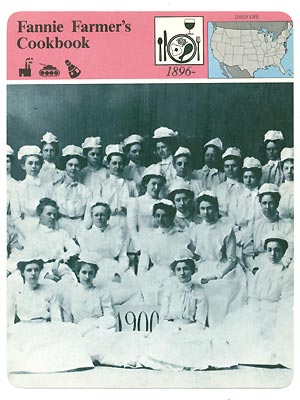
Fannie Farmer’s Cookbook
A Revolution in Home Cooking (1896-?)
Over three million copies of Fannie Farmer’s Cookbook have been sold since its first appearance in 1896. In its way, this cookbook revolutionized home cooking. While it avoided difficult, exotic recipes, it boasted a unique feature: it taught cooking as a precise science. Recipes were printed with accurate, standardized measurements, so that each dish would emerge from the kitchen the same every time.
The author, Fannie Merritt Farmer, was born in Boston, Massachusetts, on March 23, 1857. A semi-invalid, she developed an interest in cooking and was sent by her parents to the Boston Cooking School for advanced training. After graduating in 1889, she became an assistant to the director and two years later she was named director. Meanwhile she had begun collecting and compiling recipes and cooking techniques from the school’s files and her own experience. These were published for the first time in 1896 under the title The Boston Cooking School Cook Book.
The book became an instant success. In the 19 years that passed before Fannie Farmer’s death in 1915, 21 editions were published. The first edition introduced the subject of “cookery, … the art of preparing food for the nourishment of the body,†and noted that
“progress in civilization has been accommpanied by progress in cookery.†That same cookbook, which has been reprinted, revised, and updated continuously since its original publication, still emphasizes accurate measurement.
In 1902 Fannie Farmer formed her own school, called Miss Farmer’s School of Cookery. The Boston Cooking School had been established to train teachers of cookery, but Farmer wanted to teach housewives how to cook. She also taught invalid cookery and gave lectures to nurses on the subject. She even taught her course on invalid cookery one year at the venerable Harvard Medical School. Farmer wrote many other cookbooks, including Food and Cookery for the Sick and Convalescent (1904), What to Have for Dinner (1905), and Catering for Special Occasions with Menus and Recipes (1911). Although shy and retiring, she was much in demand as a speaker. Even after being confined to a wheelchair by a stroke a few years before her death, she continued her work. She always hoped that her cookbooks, especially the still popular Boston Cooking School Cook Book, would “awaken an interest through its condensed scientific knowledge which will lead to deeper thought and broader study of what to eat.â€
Illustration: Fannie Farmer and her cooking class, 1900
© 1960, Panarizon Publishing Corp. USA
Photo Mass. HistoricaI Society
Printed in Italy 030125006
the text above is printed on on the reverse of the trading card
Filed under 19th Century, 20th Century, Influential

